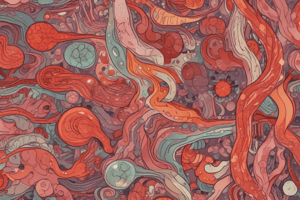Podcast
Questions and Answers
What is the affected tissue?
What is the affected tissue?
Artery
What is the diagnosis?
What is the diagnosis?
Fibrinoid necrosis in an artery
Identify the labelled structures:
Identify the labelled structures:
1 = Endothelial and inflammatory cells 2 = Pink fibrinous material
Mention two main causes that lead to this condition.
Mention two main causes that lead to this condition.
Mention two microscopic features.
Mention two microscopic features.
Identify the labelled structures:
Identify the labelled structures:
Describe what is seen in the picture.
Describe what is seen in the picture.
Is it atypical or not?
Is it atypical or not?
What is the diagnosis?
What is the diagnosis?
What is the name of the condition when dysplasia is involved in the full thickness?
What is the name of the condition when dysplasia is involved in the full thickness?
What is the cause of this condition?
What is the cause of this condition?
Mention the microscopical features seen in the picture.
Mention the microscopical features seen in the picture.
What is the excised organ that is shown in the gross picture?
What is the excised organ that is shown in the gross picture?
Write one gross feature.
Write one gross feature.
Give two histopathological features in the histological picture.
Give two histopathological features in the histological picture.
What is the diagnosis?
What is the diagnosis?
What is the probable etiology?
What is the probable etiology?
Identify the structures pointed in figure 1:
Identify the structures pointed in figure 1:
What is the type of inflammation here?
What is the type of inflammation here?
Identify the cells in the histological picture:
Identify the cells in the histological picture:
Describe what you see in the gross picture.
Describe what you see in the gross picture.
What is the diagnosis?
What is the diagnosis?
What is the type of necrosis if present?
What is the type of necrosis if present?
Is the disease caused by a microorganism?
Is the disease caused by a microorganism?
What is the causative microorganism?
What is the causative microorganism?
What is the stain used and color (appearance)?
What is the stain used and color (appearance)?
Identify the labelled structures in figure 1:
Identify the labelled structures in figure 1:
What is the diagnosis?
What is the diagnosis?
What is the malignant tumor?
What is the malignant tumor?
What is the characteristic appearance (features) of the cells in figure 2?
What is the characteristic appearance (features) of the cells in figure 2?
Give two histopathologic features.
Give two histopathologic features.
Flashcards are hidden until you start studying
Study Notes
Case #1: Fibrinoid Necrosis in an Artery
- Affected tissue: Artery
- Diagnosis: Fibrinoid necrosis in an artery
- Labelled structures:
- Endothelial and inflammatory cells
- Pink fibrinous material
- Gross features:
- Circumferential bright pink area of necrosis with inflammation
- Main causes:
- Autoimmune diseases
- Malignant hypertension
- Microscopic features:
- Circumferential bright pink area of fibrinoid necrosis
- Marked/severe inflammation or vasculitis (neutrophils with dark nuclei)
Case #2: Squamous Metaplasia
- Labelled structures:
- Lymphocytes
- Blood vessels
- Normal cells (normal columnar epithelium)
- Squamous Metaplasia
- Description:
- Central focus of squamous metaplasia of the endocervix with normal columnar epithelium at both margins
- Atypicality: Typical, just one type of cell replaced by another type (metaplasia not dysplasia)
- Diagnosis: Typical squamous metaplasia of the endocervix
- Full-thickness dysplasia: Squamous carcinoma in-situ
- Invading the basal layer: Malignant tumor
- Cause: Columnar cells are replaced by squamous cells
- Microscopical features:
- Normal columnar epithelium at both margins
- Central focus of squamous metaplasia
- Lymphocytic infiltration
Case #3: Acute Cholecystitis
- Excised organ: Gallbladder
- Gross feature: Congestion, redness, thickness of the wall
- Histopathological features:
- Infiltration of many neutrophils in the mucosa of the gallbladder
- Vascular congestion
- Diagnosis: Acute cholecystitis
- Probable etiology: Stone obstructed the neck
- Labelled structures:
- Red arrow: vascular congestion
- Blue arrow: neutrophils
Case #4: Tuberculous Lymphadenitis
- Type of inflammation: Chronic granulomatous inflammation
- Cells in the histological picture:
- Epithelioid cells
- Langhans giant cells
- Gross picture description: Swelling and scarring
- Diagnosis: Tuberculous lymphadenitis
- Type of necrosis: Caseous necrosis
- Cause: Mycobacterium tuberculosis
- Etiology: Mycobacterium tuberculosis
- Stain used: Acid-fast bacilli (AFB) stain or Ziehl-Neelsen Stain
- Color: Red or pink color and rod shape
Case #5: Intradermal Nevus
- Labelled structures in figure 1:
- Melanocytes (nevus cell)
- Melanophages
- Diagnosis: Intradermal Nevus (Benign)
- Malignant tumor: Melanoma
- Characteristic appearance of cells in figure 2:
- Small, round, or spindle-shaped cells
- Typically arranged in nests and clusters
- Symmetrical (Circumscribed)
- Different colors (Pink – Tan – Brown etc)
- Histopathologic features:
- Proliferating benign intradermal melanocytes
- Nevus cells concentrated in the dermis
Studying That Suits You
Use AI to generate personalized quizzes and flashcards to suit your learning preferences.




